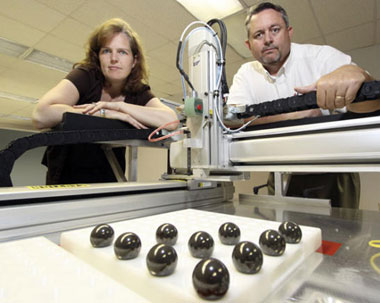Vibrant Corp. Shakes Out More Business

Jeanne Jaurique (left) and Gregory Weaver watch Vibrant’s robotic machine test ceramic-based ball bearing. Photo by Randy Siner | NMBW
September 3, 2010 | Reprint from New Mexico Business Weekly; by Kevin Robinson-Avila
Vibrant Corp. netted some major boosts this summer from the Federal Aviation Administration and the U.S. Department of Defense.
The venture-backed company based in Albuquerque conducts non-destructive testing of aerospace components. The firm has worked with Delta Air Lines to apply its tests to turbine blades used in Pratt & Whitney JT8D engines that Delta uses on some aircraft.
Delta earned FAA approval in June to use Vibrant’s new process. That could lead to a huge increase in contract work with Delta, and possibly with other aviation companies, said Vibrant President and CEO Lem Hunter.
“Our testing volume with Delta has increased significantly as a result of the FAA certification,” Hunter said. “I can’t reveal the value, but it’s the type of contract that can support a small company by itself. We’ve also got lots of new inquiries coming in from other companies. The phones have started to ring.”
Vibrant also won a Phase III, Small Business Innovation Research contract from the U.S. Air Force and Navy in July to continue adapting its system for testing of ceramic-based ball-bearing parts for military aircraft, Hunter said.
The company has received about $865,000 from two previous SBIR phases since 2008.
Vibrant uses technology licensed from Quasar International. The system detects defects in parts by vibrating them and applying advanced software algorithms to compare the resonant frequency generated with the resonance of a non-defective part.
Vibrant Director of Operations Gregory Weaver said the system offers a better, faster and greener inspection process than other methods.
“Current inspections are subjective,” Weaver said. “We take the subjectivity out by making the inspection a pass-fail test with detailed statistics. It’s much faster, because we can inspect a part in about 10 seconds, while most others today take anywhere from a few minutes to 30 minutes or more.”
It’s cleaner, because many companies use chemical products in their inspection processes, but not Vibrant, Weaver said.
Quasar only used the system to test automotive parts, but Hunter adapted it for the aerospace industry. He incubated Vibrant at Mechtronic Solutions Inc.—a local engineering firm that Hunter started in 1993—and spun it out as an independent startup in 2007.
Vibrant has received more than $2 million from the Verge Fund and the New Mexico Angels.
Verge General Partner Dave Durgin said the company has done a great job of adapting and proving the technology.
“It’s a challenge to adapt new technology to the aviation industry and get customers behind it,” Durgin said. “FAA certification could lead to some incredible future opportunities.”
Vibrant and Delta worked together to adapt and vet the system.
Previously, Delta took one of 64 blades out of the JT8D engines for testing when doing inspections. If it found a defect in that part, it would scrap all 64 blades, Hunter said.
“Now, they can test each blade, and only those with defects are replaced,” Hunter said. “Delta’s old method took two weeks to inspect just one blade. We can inspect all 64 blades in about five hours.”
The federal agency’s certification is only for turbine blades on the JT8D engine, but that approval makes certification for other parts easier, Hunter said.
Delta wants to apply the process to a lot more components, Weaver said.
David Piotrowski, principal engineer with Delta in Atlanta, said his company is preparing a public announcement on the FAA certification.
“I can’t comment until then, but it is indeed good work by Vibrant and it’s actually a boon to the industry,” Piotrowski said. “It’s raising some eyebrows.”
Meanwhile, the Small Business Innovation Research contract is helping the Albuquerque company further develop its system, said Director of Technology Leanne Jaurique.
“We’re working on new hardware to reach a higher frequency range to aid in detecting defects on ceramic parts,” Jaurique said.
Vibrant created a new, robotic machine for manufacturers to inspect ceramic bearings at real production rates. It operates as the components roll off the line.
Five industry partners are collaborating on the SBIR contract.
Their identities are confidential, but it’s giving Vibrant exposure to potential future clients, Jaurique said.
Vibrant employs eight. It expects to hire four more workers over the next 18 months.
krobinson-avila@bizjournals.com | 505.348.8302
